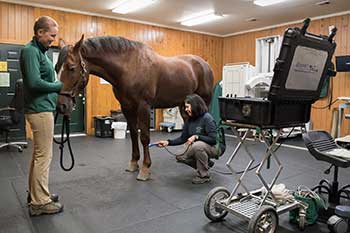How Laser Therapy in Equine Therapy Is Reinventing Veterinary Take Care Of Horses
Laser treatment has actually arised as a transformative strategy in equine vet treatment, giving a non-invasive remedy that expedites healing and enhances overall health and wellness. The mobility and adaptability of laser treatment gadgets additionally emphasize their expanding necessity amongst vets.

Comprehending Laser Treatment
Comprehending laser therapy is vital for appreciating its function in equine therapy. Laser treatment, likewise referred to as photobiomodulation, involves the application of certain wavelengths of light to tissues, which can cause numerous organic results. This healing method takes advantage of the power of light power to permeate the skin and underlying tissues, stimulating mobile procedures and boosting tissue repair service.
The technology behind laser treatment is grounded in the concept of photochemistry, where photons are soaked up by chromophores within cells, resulting in increased ATP manufacturing and modulation of reactive oxygen varieties. This, consequently, advertises mobile proliferation, reduces swelling, and speeds up recovery. Veterinary practitioners utilize various sorts of lasers, consisting of low-level lasers (LLLT) and high-power Course IV lasers, relying on the specific restorative objectives and the nature of the equine condition being treated.
Various laser wavelengths and power setups are carefully picked to target different tissue depths and attain desired professional results. Safety procedures are extremely important, as incorrect use can lead to thermal damages or suboptimal healing effects. Therefore, a comprehensive understanding of laser therapy's devices and applications is essential for its efficient execution in equine vet technique.
Advantages for Equine Health And Wellness
The myriad advantages of laser treatment for equine health include improved recovery, discomfort reduction, and improved wheelchair. This innovative treatment modality leverages certain wavelengths of light to pass through cells, stimulating cellular function and promoting fast cells repair service. The non-invasive nature of laser treatment ensures minimal tension and discomfort for the equine, promoting a smoother recovery process.

Improved flexibility is one more crucial benefit, particularly for efficiency and working horses. By decreasing inflammation and discomfort, and boosting tissue repair service, laser treatment aids in restoring joint feature and muscle mass versatility. The cumulative result of these benefits is not only a quicker go back to normal task but additionally a general improvement in the equine's top quality of life. Therefore, laser treatment stands as a transformative tool in modern-day equine vet care.
Typical Problems Treated
Laser treatment has actually become a functional treatment choice for a selection of typical equine problems. Among these, musculoskeletal injuries are specifically amenable to laser therapy. Soft cells injuries, such as tendonitis and ligament pressures, gain from the anti-inflammatory and analgesic impacts of laser treatments, which speed up recovery and decrease discomfort. Additionally, laser treatment works for conditions like osteo arthritis, where it aids alleviate joint inflammation and advertise tissue repair.
Wound monitoring is another area where laser therapy has actually revealed significant guarantee. Chronic injuries or slow-healing abscess can be particularly challenging in horses, but laser treatment boosts mobile regrowth and improves blood circulation, therefore expediting the healing procedure. Laser therapies have actually been effectively utilized in managing hoof problems such as laminitis and abscesses, easing pain and advertising much faster healing.
Equine athletes often suffer from performance-related concerns like official source muscle mass discomfort and tension go to my site fractures. Laser treatment aids in reducing muscular tissue fatigue and expedites the recuperation of micro-injuries, therefore guaranteeing that steeds go back to peak efficiency a lot more rapidly. By addressing these varied conditions, laser treatment is transforming the landscape of vet care, providing a non-invasive, reliable option to traditional therapies.
Innovation Behind Laser Treatment

Laser tools made use of in veterinary medicine often make use of low-level laser therapy (LLLT) or chilly laser treatment. Unlike high-powered surgical lasers, these gadgets run at lower power degrees, enhancing therapeutic advantages while decreasing thermal damages. The power from the laser light promotes adenosine triphosphate (ATP) manufacturing, enhances mobile metabolism, and speeds up tissue fixing processes.
Modern laser therapy equipment for equine treatment is designed with flexible setups to provide to the certain requirements of different tissues and conditions. Additionally, advancements in laser technology have actually led to the growth of mobile, handheld devices, making it simpler for veterinarians to give therapy in a range of settings, from facilities to stables.
Success Stories and Study
Showcasing the concrete benefits of laser treatment, many success stories and study illuminate its transformative effect on equine wellness. One such situation involves a pure-blooded racehorse struggling with chronic tendonitis. Typical treatments yielded marginal enhancement, but after incorporating laser treatment into the regimen, the steed showed considerable reductions in swelling and discomfort within weeks, eventually returning to competitive auto racing.
An additional compelling instance includes a dressage horse identified with extreme neck and back pain, restricting its performance. A vet team utilized low-level laser treatment (LLLT) to target the inflamed areas, causing marked enhancement in adaptability and a noteworthy decline in discomfort. Over several sessions, the equine reclaimed its peak form, showcasing the effectiveness of laser treatment in addressing musculoskeletal problems.
In addition, a research carried out at a leading equine facility analyzed 50 equines with numerous soft cells injuries treated with laser therapy. The outcomes were striking: web link 85% of the horses demonstrated increased healing times and enhanced mobility. These situations highlight the adaptability and performance of laser treatment in equine medicine, providing a non-invasive, scientifically-backed method to boosting recuperation and efficiency in equines.
Conclusion
Laser therapy is transforming equine vet care by supplying a non-invasive therapy that increases healing, lowers swelling, and relieves pain. With its performance in treating a variety of problems, from musculoskeletal injuries to chronic disorders like osteo arthritis, this modern technology substantially boosts equine health and wellness and wheelchair. The mobility and adaptability of laser therapy further highlight its transformative influence on vet methods, solidifying its duty as an essential device in contemporary equine healthcare.